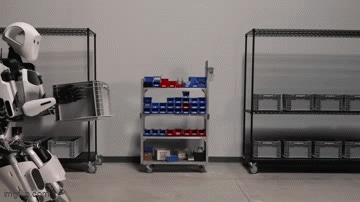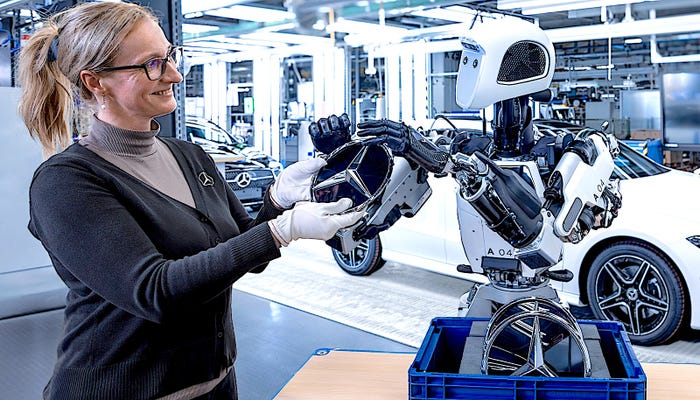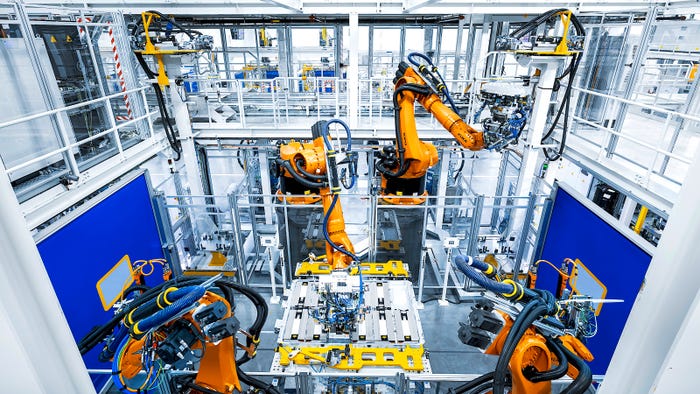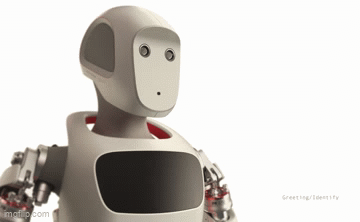Mercedes Puts Apollo Robot to Work
Will Apptronik’s Apollo humanoid robot have to join the union?

At a Glance
- 5 feet, 8 inches tall
- 160 lbs.
- Carries 55 lbs.
Mercedes-Benz is testing Apptronik’s humanoid robot, Apollo, for factory work as a go-fer for human assembly line workers.
As in other careers, entry-level workers commonly start their careers as “go-fers,” who are sent to go for things needed by more skilled workers. In this case, the Apollo robots will be tasked with fetching bins of parts for the human assembly line workers to install.
In the popular imagination, “robot” means android, a human-shaped machine like C3-PO or Star Trek’s Commander Data. In manufacturing, “robot” typically means an articulated arm mounted in place that picks up a part, places it, and fastens it in place. This is much less glamorous, or, seemingly threatening, judging from online reactions to videos of Boston Dynamics’ robots demonstrating various skills.
An advantage of humanoid robots is that they can work in spaces that were designed for humans, rather than being caged off from humanity to prevent injurious interactions with people. This means that they can potentially be sent into hazardous situations where it isn’t safe to send people. They might be able to let the workers profiled by Mike Rowe’s Dirty Jobs show switch to less grimy work.
To gain the capability of being helpful by cleaning sewers or fixing running nuclear reactors, humanoid robots need to learn how to work. And like human workers, that starts with being a go-fer for experienced workers. This is where Mercedes’ latest factory hire will start.
Apptronik’s Apollo humanoid robots will work in the logistics department, bringing containers of parts called assembly kits to the production line for human workers to assemble. They’ll provide a quality control benefit too, as Apollo can scan the contents of the kit while carrying it, inspecting the components to ensure everything is there.

Apollo delivers a Mercedes forward radar module. APPTRONIK
Humanoid robots like Apollo can join human employees in factories and plants like Mercedes’, working in spaces that are designed for humans. This avoids full-scale facility redesigns that are built around robots rather than people. This approach centers on automating the kind of physically demanding, repetitive, and dull tasks that humans dislike.
“When we set out to build Apollo, an agreement like the one we’re announcing today with Mercedes-Benz was a dream scenario,” said Jeff Cardenas, co-founder & CEO of Apollo. “Mercedes plans to use robotics and Apollo for automating some low-skill, physically challenging, manual labor – a model use case which we’ll see other organizations replicate in the months and years to come.”
“We are exploring new possibilities with the use of robotics to support our skilled workforce in manufacturing,” remarked Jörg Burzer, Member of the Board of Management of Mercedes-Benz Group AG, Production, Quality & Supply Chain Management. “This is a new frontier and we want to understand the potential both for robotics and automotive manufacturing to fill labor gaps in areas such as low-skill, repetitive, and physically demanding work and to free up our highly skilled team members on the line to build the world’s most desirable cars.”

Automotive factory robots usually look like these, which assemble battery packs for Mercedes-Benz EVs. MERCEDES-BENZ
Apptronik’s Apollo resembles an average person, standing 5’8” tall and weighing 160 lbs. Apollo can lift 55 lbs. Humans can probably lift more, but they don’t want to do it all day long and can’t do so without injuring their backs. Apollo presumably doesn’t need to wear a back brace all day at work or visit the chiropractor afterward.
“At Interact Analysis our research suggests that the flexibility and scalability humanoid robots offer could be a possible answer to ongoing labor and skills shortages,” wrote Ash Sharma, Managing Director at market intelligence firm Interact Analysis on his company’s blog. “Humanoid robotic solutions are the next step in the evolution of the industry as customers look for more flexible automation that can be used across multiple workflows”
Because Apollo is not fenced off like traditional factor robots, it incorporates a unique force control architecture that maintains safe operation around people, while taking on physically demanding tasks. Its perimeter zone is adjusted to suit the working environment to avoid contact with people, while its smaller impact zone invokes an immediate stopping of any movement.
Apollo’s battery is good for four hours of work and it is swappable, so it can work a full eight-hour shift with one battery change. Alternatively, if Apollo’s range is limited, it can work plugged in for continuous operation.

Apollo introduces itself. APPTRONIK
Apptronik says that Apollo’s computing platform is open to new applications, so leading AI companies can solve other use cases outside the ones that Apptronik will initially solve such as toting boxes of parts for Mercedes. Displays on Apollo’s face and chest provide familiar means of communication with its human coworkers, approximating a congenial face-to-face exchange.
Recalling pandemic supply chain disruptions, Apptronik has avoided single-sourced core components to ensure resilience. The company also points to its Austin location near what it terms “the Texas-Mexico manufacturing corridor” to help ensure stable manufacturing.
While Apollo will start as a simple go-fer, like any parent, Apptronik aspires to much more for its progeny. They remind us that Apollo is a general-purpose robot that is designed to work in the real world in industries such as construction, oil and gas, electronics production, retail, home delivery, and elder care.
Apollo’s potential in the elder care industry was previewed in the movie, Robot and Frank. Hopefully, Apptronik’s programmers have seen that movie and will code in some sort of Prime Directive that prevents Apollo from being co-opted into a retired burglar’s ambitions for a return to action!
About the Author(s)
You May Also Like





